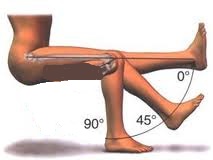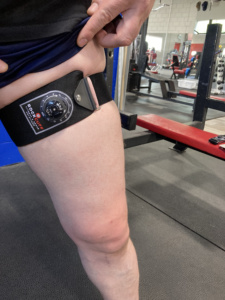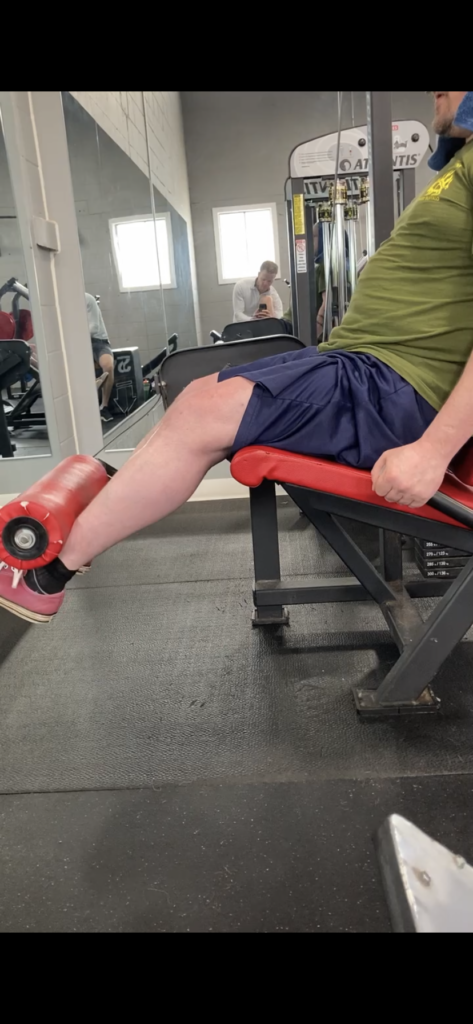Depending on what you Google or who you talk to you can get a large variance in answers when it comes to the safe application of resisted open kinetic chain (OKC) knee extensions aka seated knee extensions following ACL reconstruction (ACLR). This can be a source of concern and frustration for patients that want to put 100% into their ACL rehab but come across conflicting advice when it comes to seated knee extensions and ACL rehab. Thankfully there is a growing amount of research that is available to support the clinical decision making and programming of seated knee extensions following ACLR.
Before we get into the research of the safe application of seated knee extensions it is important to note why seated extensions are an integral part of post-op ACLR rehab. Seated knee extension is the best exercise to isolate and target the quadricep muscle group. Strength symmetry in the quadriceps muscle group is vital to restoring adequate knee function after ACLR, especially as it relates to ability to return to sport, incidence of subsequent knee injury and the long-term development of osteoarthritis1. Therefore, the safe application of seated knee extensions following ACLR is vital to ACLR rehab outcomes.

What does the Research Say?
Now that we know the benefits of including seated knee extensions following ACLR we need to highlight the potential risks of this exercise with poor exercise programming/awareness. Wilk et al2 reported that during seated knee extension there is minimal to no hamstring activity, and therefore no co-contraction to the quadriceps. Furthermore, near end range knee extension (40-0 degrees of knee flexion) the amount of quadriceps force to extend the knee joint is 3-4 times greater. Therefore, the seated knee extension creates an environment where there is unopposed anterior shear forces placed on the ACL graft. This force is exponentially greater at end range knee extension.
In addition to the above, Beynnon et al3 performed a study that placed strain gauges into normal subjects ACLs. They discovered that the greatest amount of strain was at 40 to 0 degrees knee flexion and that as resistance increased, so too did the amount of strain placed on the ACL. This can be especially harmful to hamstring grafts that are more susceptible to graft stretch out and long-term ligament laxity.
So how do we balance the obvious benefits of seated knee extensions with the researched risks of the same exercise? The answer is relatively simple. We program seated knee extensions with a strict range of motion restriction between 90 and 35 degrees flexion.
Beynnon et al3,4 discovered that seated knee extension performed between 35-90 degree knee flexion produced little to no strain on the ACL. Therefore, using restricted range of motion we can safely load seated knee extensions and reap the benefits of quad strength without risking strain and long term laxity to the ACL graft.

Seated Knee Extension and Blood Flow Restriction Training
Another modification we can make to further the safety of seated knee extensions is adding the use of Blood Flow Restriction (BFR) cuffs. It is widely recognized that strength training should be performed at 70-80% of an individuals 1 repetition maximum (1RM). With the application of BFR cuffs we can load individuals at 20-30% 1RM and achieve similar strength results as if loading at the aforementioned 70-80% 1RM. The implementation of seated knee extensions with BFR training is a necessity in regaining strength following ACLR.

In Conclusion
The benefits of the seated knee extension exercise include isolating and building quadricep strength. The restoration of quadricep strength symmetry in ACLR is vital for return to sport and reducing the risk of subsequent ACL injuries. Seated knee extensions can be safely implemented at a restricted range of motion between 35-90 degrees of knee flexion. To further the safety of the ACL graft BFR training can be implemented to create strength gains at lower levels of external load.
The Physiotherapists at Modern Physiotherapy and Training are highly trained health professionals in ACL rehab. They have direct access to a fully equipped gym and blood flow restriction cuffs. This allows them to program and supervise the safe implementation of these exercises early in ACLR rehab and provide you with the best rehab outcomes.
For more information you can contact david@modernphysio.ca
Citations
1 Lepley LK. Deficits in quadriceps strength and patient-oriented outcomes at return to activity after ACL reconstruction: A review of the current literature. Sports Health. 2015;7(3):231-238.
2 Wilk KE, Escamilla RF, Fleisig GS, Barrentine SW, Andrews JR, Boyd ML. A comparison of tibiofemoral joint forces and electromyographic activity during open and closed kinetic chain exercises. Am J Sports Med. 1996;24(4):518-527
3 Beynnon BD, Johnson RJ, Fleming BC, Stankewich CJ, Renström PA, Nichols CE. The strain behavior of the anterior cruciate ligament during squatting and active flexion-extension. A comparison of an open and a closed kinetic chain exercise. Am J Sports Med. 1997;25(6):823-829.
4 . Beynnon BD, Fleming BC, Johnson RJ, Nichols CE, Renström PA, Pope MH. Anterior cruciate ligament strain behavior during rehabilitation exercises in vivo. Am J Sports Med. 1995;23(1):24-34
5 Slysz J, Stultz J, Burr JF. The efficacy of blood flow restricted exercise: A systematic review & meta-analysis. J Sci Med Sport. 2016; 19(8):669-675


